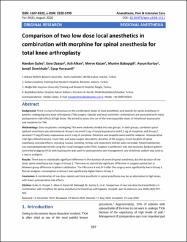Comparison of two low dose local anesthetics in combination with morphine for spinal anesthesia for total knee arthroplasty

View/
Date
2020Author
Güleç, HandanOzayar, Esra
Alkan, Aslı
Kaçan, Merve
Babayiğit, Münire
Kurtay, Aysun
Horasanlı, Eyüp
Metadata
Show full item recordAbstract
Background: There is a lack of consensus on the combination doses of local anesthetics and opioids for spinal anesthesia in patients undergoing total knee arthroplasty (TKA) surgery. Opioids and local anesthetic combinations are associated with many postoperative side effects at high doses. We aimed to assess the use of the lowest possible doses of intrathecal bupivacaine and morphine for TKA. Methodology: Sixty-six patients undergoing TKA were randomly divided into two groups. In both groups, combined spinal epidural anesthesia was administered. Group 1 received 5 mg of heavy bupivacaine and 0.1 mg of morphine, and Group 2 received 7.5 mg of heavy bupivacaine and 0.1 mg of morphine. Ketamine and propofol were used for sedation. Intraoperative vital signs (blood pressure, heart rate, and pulse oxygen saturation), duration of the surgery, onset duration of spinal anesthesia, and side effects, including nausea, vomiting, itching, and respiratory distress were recorded. Patient satisfaction was assessed postoperatively using the visual analogue scale (VAS). Surgeon's satisfaction was also assessed. Epidural patient-controlled analgesia (PCA) with bupivacaine was used for postoperative pain management, and diclofenac sodium was used as a rescue analgesic. Results: There was no statistically significant difference in the duration of onset of spinal anesthesia, but the duration of the onset spinal anesthesia was longer in Group 2. There was no statistically significant difference in surgeon satisfaction or between-group difference in patient satisfaction. The VAS score 4 and 24 h after the surgery were significantly low in Group 1. Rescue analgesic consumption in Group 1 was significantly higher than in Group 2. Conclusion: A combination of low-dose opioids and local anesthetic in spinal anesthesia may be an alternative to high doses, with fewer postoperative side effects.

















